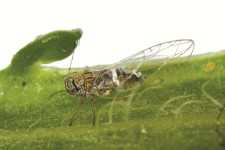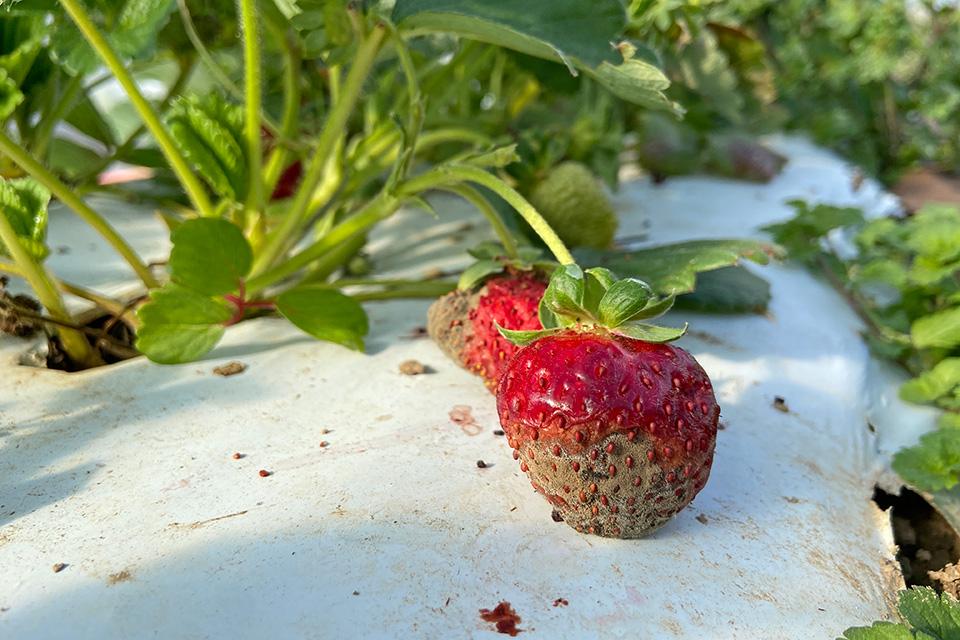Zebra Chip Management Recommendations

Adult psyllids collected from a sticky card in a commercial potato field in Idaho in June proved to be positive for Liberibacter, the bacterium that causes zebra chip. It’s the first such find in 2012, after being originally found in the state the previous year.
“This is the first (preliminary) finding of Liberibacter-infected psyllids in the Pacific Northwest this season; however, we still strongly recommend that fields be scouted in order to make the most sound and appropriate management steps for a given field,” wrote Erik J. Wenninger, a University of Idaho assistant professor of entomology and Extension specialist, in a blog post.
Wenninger and his counterparts at universities and other research institutions in the Pacific Northwest recently issued a report on handling the disease and the pest which vectors it, the potato psyllid. They note zebra chip has caused millions of dollars in losses to the potato industry in the southwestern U.S., particularly Texas. It’s of critical interest in the Northwest because the area produces more than half of the potatoes grown
in the U.S. Here are the researchers’ management recommendations.
Sampling
A sampling program to monitor psyllid populations is a fundamental tool for a successful IPM program.
Yellow sticky cards: Unbaited yellow sticky cards are recommended to detect the first occurrence of psyllid in the area, though their sensitivity to confirm psyllids at low population (early in the season) may be low. Start seasonal sampling as soon as the potato season starts. Replace sticky cards weekly.
Sticky traps will likely be most useful for detecting psyllid migration into and out of fields. Spatial and temporal studies indicate that both psyllid abundance and zebra chip incidence progress faster on the edges than in the infields early in the season.
As the season progresses, psyllids become more evenly distributed throughout the field. Placement of cards outside of fields is not effective for monitoring potato psyllids.
Texas recommendations include the use of at least five yellow sticky cards. The more cards per field, the more likely you are to detect psyllids.
Sweep net and aspirator: Considering that adult potato psyllids are active and fly or jump away when disturbed, a sweep net plus an aspirator or DVAC (inverted leaf blower) are also recommended. Texas recommendations also call for 100 sweeps from around the field perimeter. If you use a DVAC, be sure to use it 5 to 10 feet from the field edge for at least five minutes.
For more information on using a sweep net, see http://oregonstate.edu/dept/hermiston/silvia-rondon.
Leaf sampling: Collect 10 leaves from 10 locations among the 10 outer rows of the field. Collect full-size leaves from the middle of the plant to look for psyllid eggs or nymphs. A hand lens is required to see these life stages.
The nymphs reside on the underside of the leaf. Eggs are most commonly present on the leaf’s edges and underside. However, if the psyllid population is high, eggs can be found everywhere.
Keep in mind that this is not the preferred method for determining the first occurrence of these insects. Leaf sampling confirms that psyllids are already colonizing the field, and zebra chip infection will likely have happened by then if the psyllids are carriers of the bacterium.
Action Threshold
No action threshold exists for psyllids in potato. Until more is known, the researchers suggest that the threshold for action is detection of potato psyllids at any level, in any life stage.
In 2011, some growers in the Columbia Basin and southwest and central Idaho faced low zebra chip damage (1% to 2%) even though they did not see psyllids in their fields. This indicates the difficulty in trapping psyllids when the populations are low and in keeping fields free of zebra chip when relying on trapping data.
Control
There are no effective non-chemical control tactics for potato psyllids, although research is under way in this area. However, there are a number of insecticides registered on potatoes that have activity against potato psyllids in the adult and/or immature stages.
Season-long, weekly applications are used in areas where zebra chip has been problematic. At this point, Northwest recommendations are not expected to follow the same lengthy period of control since psyllids are not thought to be in potato fields in the early part of the season. Growers can search information regarding chemical control options at http://potatoes.com/Research.cfm and http://insects.ippc.orst.edu/pnw/insects.
Resistance Management
The risk of insects developing resistance to insecticides can be reduced with adequate planning. Be sure to follow insecticide resistance management plans.
In the Northwest, the first psyllid life stage detected is usually the adult. In control programs in other states, when adults are detected, it is recommended that a product with activity against adults be used first.
There are some anecdotal reports that imadicloprid products are no longer effective against psyllids, but this potential problem needs further investigation.









